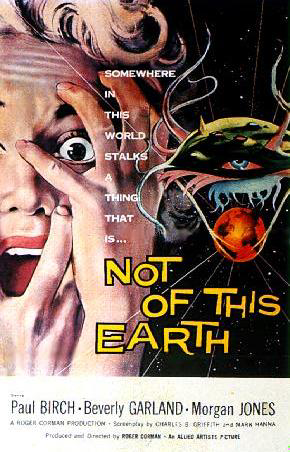

Xenophobia
 Mob
behavior governs the actions of characters in many science fiction films.
Rampant xenophobia fueled by the Cold War fostered conformity to certain norms
and conventions in the 1950's. The suburbanizaiton of America reinforced conformity,
creating a vast middle class. Middle class tastes materialized into consumerism,
producing external indicators of conformity. Thus, keeping up with the Jones'
equates to being American. Everyone lived in the same house, drove the same
care, and wore the same clothes. Anyone who deviated from the norm was a suspect
of communist sympathy. Science fiction films of the 1950's portray xenophobia
as a vicious phenomenon that is based upon irrationalities. The mob in It
Came from Outer Space (1953) almost attacks the aliens who do not intend to
harm humans. A hate-filled sheriff, who makes no attempts to assess the situation
in a reasonable manner, leads the mob. In The Day the Earth Stood Still (1951),
people speculate that the newly arrived alien, who comes in peace, is probably
a Soviet.
Mob
behavior governs the actions of characters in many science fiction films.
Rampant xenophobia fueled by the Cold War fostered conformity to certain norms
and conventions in the 1950's. The suburbanizaiton of America reinforced conformity,
creating a vast middle class. Middle class tastes materialized into consumerism,
producing external indicators of conformity. Thus, keeping up with the Jones'
equates to being American. Everyone lived in the same house, drove the same
care, and wore the same clothes. Anyone who deviated from the norm was a suspect
of communist sympathy. Science fiction films of the 1950's portray xenophobia
as a vicious phenomenon that is based upon irrationalities. The mob in It
Came from Outer Space (1953) almost attacks the aliens who do not intend to
harm humans. A hate-filled sheriff, who makes no attempts to assess the situation
in a reasonable manner, leads the mob. In The Day the Earth Stood Still (1951),
people speculate that the newly arrived alien, who comes in peace, is probably
a Soviet.
 On
the other hand, some science fiction films possess xenophobia themselves,
depicting any foreign element with suspicion. In This Island Earth (1955),
the heroic scientists are American while the German and Chinese scientists
corroborate with the aliens. Heroes in science fiction films of the 1950's
are truly all-American. White actors and actresses of Anglo-Saxon decent,
with no traces of other ethnicity depict these all-American heroes. The human
villains in science fiction films, often scientists, do not fit this mold.
Dr. Morbius of Forbidden Planet (1956) is the villain while the hero is Commander
John J. Adams. In Fiend without a Face (1958), a British scientist is responsible
for unleashing the dangerous alien. In the end, science fiction films reaffirm
a belief in American ways.
On
the other hand, some science fiction films possess xenophobia themselves,
depicting any foreign element with suspicion. In This Island Earth (1955),
the heroic scientists are American while the German and Chinese scientists
corroborate with the aliens. Heroes in science fiction films of the 1950's
are truly all-American. White actors and actresses of Anglo-Saxon decent,
with no traces of other ethnicity depict these all-American heroes. The human
villains in science fiction films, often scientists, do not fit this mold.
Dr. Morbius of Forbidden Planet (1956) is the villain while the hero is Commander
John J. Adams. In Fiend without a Face (1958), a British scientist is responsible
for unleashing the dangerous alien. In the end, science fiction films reaffirm
a belief in American ways.